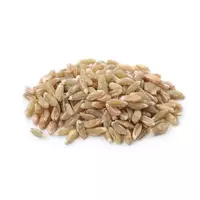Spelled

Often, the spelt, which is the progenitor of modern wheat varieties, is called nothing more than "black caviar of cereals. " She owes such a high title to outstanding taste, worldwide popularity and undoubted utility for human health.
Polba refers to ancient and unpretentious types of wheat. The grains of this cereal are soaked not clean, but with flowering and spikelet scales that grow to them, so grinding the spelt into flour is quite difficult. That is why over time, this cereal was replaced by holozero wheat varieties, which are of higher quality, but at the same time they are much more whimsical to soil fertility.
Representing a semi-wild wheat variety, any soil fits the spelt, it is quite resistant to dry winds and loves light. As it turned out, even at the dawn of our civilization, she became a human companion. Polba began to be used for food in the Neolithic era, and in ancient Babylon and Egypt it was the main cultivated cereal crop.
Recently, experts in the field of dietetics have again started talking animatedly about polba. It is clear that this is caused by the increased interest of the modern person in healthy eating. The menu of some restaurants even began to appear original dishes with the use of this cereal: in addition to traditional porridge, soups and bread and spelt, you can try tender sauces and air creams with the addition of ground cereals of this plant or half-baked crumbs. This ancient culture has gained wide recognition of connoisseurs abroad: in Italy, risotto is prepared from it, and Turks, Iranians and Hindus - a variety of side dishes for fish and poultry.
This plant is also cultivated by Belgians: here spelt grains are components of the traditional local Joseph beer. But the British went the farthest: the indigenous people of Wales use the spelt to bake "Bread of Heaven. " The producers of "divine" bread assure that they make it from the same spelt that was present during the Last Supper on the table of Jesus Christ and the seven apostles. It is clear why the cost of such a "spiritual" meal is 4 times higher than the price of ordinary bread.
In the cuisine of the Slavic peoples, polba is also highly revered and used as an excellent basis for soups and chowder. Many chefs add it to salads or serve it with vegetables. The spelt is a good match with wine, in particular red, and the delicate porridge with a pleasant nutty aroma, made from this wonderful cereal, is incredibly useful for children and people of the older generation.
poles 337 kCal
Energy value of the spelt (Ratio of proteins, fats, carbohydrates - ju):
Proteins: 14.7 g (~ 59 kCal)
Fats: 2.2 g (~ 20 kCal)
Carbohydrates: 61.28 g. (~ 245 kCal)
Energy ratio (b | y): 17% | 6% | 73%
 Español
Español Français
Français Português
Português Русский
Русский 简体中文
简体中文 繁體中文
繁體中文 日本語
日本語 한국어
한국어 العربية
العربية Türkçe
Türkçe Қазақ
Қазақ Deutsch
Deutsch Italiano
Italiano Українська
Українська
